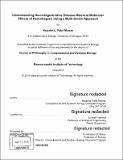Understanding neurodegenerative disease-relevant molecular effects of perturbagens using a multi-omics approach
Author(s)
Patel-Murray, Natasha L.(Natasha Leanna)
Download1124074218-MIT.pdf (17.93Mb)
Other Contributors
Massachusetts Institute of Technology. Computational and Systems Biology Program.
Advisor
Ernest Fraenkel.
Terms of use
Metadata
Show full item recordAbstract
The complex etiology of neurodegenerative diseases is not fully understood, and the characterization of cellular pathways that are dysfunctional in these diseases is key for therapeutic development. Chemical and genetic perturbagens can probe cellular pathways to shed insight about both disease etiology and potential therapeutic targets. We analyzed the functional effects of chemical perturbagens in neurodegenerative disease models as evidenced by changes in transcriptomic, metabolomic, epigenomic, and proteomic data ("multi-omics" data). Our studies revealed novel modes of action for small molecule compounds that promote survival in a model of Huntington's Disease, a fatal neurodegenerative disorder. Integration of our multi-omics data using an interpretable network approach revealed that the autophagy and bioenergetics cellular pathways are affected by different sets of compounds that promote survival. Using staining and western blot assays, we validated the effect on autophagy for one set of compounds and found that the compounds activate this pathway. Using a cellular bioenergetics assay, we found that a second set of compounds shifts the bioenergetic flux from mitochondrial respiration to glycolysis, validating our network results. In a second study related to Huntington's Disease, we analyzed the effects of two peripheral huntingtin gene silencing techniques in mouse liver. We show that the transcriptional and metabolomic changes associated with both genetic silencing methods converge on similar cellular pathways, such as the immune response and fatty acid metabolism. As a whole, this thesis presents new insights into the functional effects of perturbagens that could impact neurodegenerative disease pathology and drug discovery.
Description
Thesis: Ph. D., Massachusetts Institute of Technology, Computational and Systems Biology Program, 2019 Cataloged from PDF version of thesis. Includes bibliographical references.
Date issued
2019Department
Massachusetts Institute of Technology. Computational and Systems Biology ProgramPublisher
Massachusetts Institute of Technology
Keywords
Computational and Systems Biology Program.